P-38 Pilot Loved the Lightning
Use controls above or click here to open this Hometown Heroes podcast in a new window
95-year-old Don Stoutenborough of Laguna Woods, CA appears on episode #537 of Hometown Heroes, airing August 16-19, 2018, remembering his 76 World War II missions as a P-38 pilot with the 95th Fighter Squadron, 82nd Fighter Group.
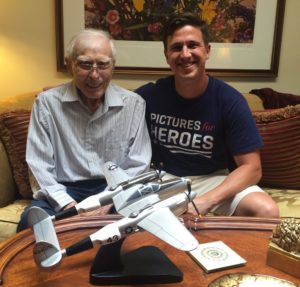
Don Stoutenborough with Zach Coco, who photographed the P-38 pilot for his Pictures for Heroes project. For more photos, visit the Hometown Heroes facebook page.
“I wanted to fly, period,” you’ll hear Stoutenborough remember about his childhood years in Riverside, CA. “It was almost an obsession. I bothered my folks about it.”
Listen to Hometown Heroes for the creative manner in which Don’s father facilitated the boy’s first opportunity to fly, sitting on his mother’s lap in the back seat of a Stearman biplane. “I caught the bug,” you’ll hear Stoutenborough say of that first experience in the air. “I really did.” While his friends built model airplanes, young Don dreamed of flying the real thing. When he was 12, his mother died after a lengthy illness. Frequent moves and his father’s second marriage presented challenges during his teen years, but his affinity for aviation did not waver. Little did he know that an experimental plane he spotted in rural Riverside County would become the aircraft he would fly in combat during World War II. He would ride his bike to the country and then run in an area where March Field was in view. On one such journey, he was captivated by what he witnessed in the air.
“I couldn’t figure out what that plane was, and it made it’s little turn,” he recalls. “It had no inside! I’d never seen a P-38 before.”
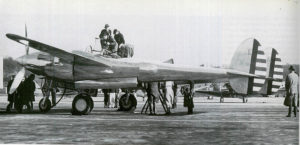
The XP-38 prototype piloted by Ben Kelsey is what Don spotted over March Field in 1939. Click here for more about Kelsey and the XP-38 project.
Stoutenborough would later learn that what he saw was the XP-38 prototype, flown by Lt. Ben Kelsey. The plane would be damaged on a transcontinental flight from Riverside to New York in which it set a speed record, but as the first American fighter plane to exceed 400 miles per hour, it had proved its worth. In the years that followed, Lockheed would produce more than 10,000 P-38s in its Burbank, CA factory that was expertly camouflaged to avoid detection by the Japanese.
When he first saw the XP-38 in flight, none of his friends at school would believe his story. After the Japanese attack on Pearl Harbor, Don’s subsequent decision to join the Army Air Corps, and his ultimate assignment to the 82nd Fighter Group, there could be no dispute.
Note the humility and transparency as you listen to Stoutenborough’s memories of the 76 missions he flew with the 95th Fighter Squadron; 50 in his first tour of duty, 26 more after rotating home and getting married. He was just 20 years old when he joined the 82nd Fighter Group overseas in 1943, just in time to participate in a strafing mission that decimated enemy airfields and produced a Distinguished Unit Citation for the group. The first of two aerial victories would come on October 8, 1943. You’ll hear Stoutenborough downplay his actions that day, and share how he prefers to view the result of that mission, but as was the case with quite a few of those 76 missions, he was fortunate to survive. Escorting 321st Bomb Group B-25s to and from their targets in Athens, Stoutenborough and other P-38 pilots from the 95th and 96th squadrons were attacked by German fighter planes.
“As the formation left the target,” states an official account of the mission. “A dozen or so ME-109s attacked the 95th from above and behind, utilizing the cloud cover to their advantage. A running fight then ensued over the Gulf of Corinth.”
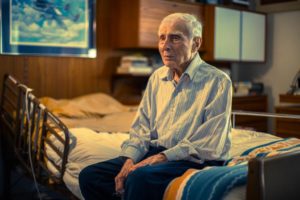
95-year-old Don Stoutenborough, as photographed by Zach Coco, Pictures for Heroes
Two P-38s from his squadron were shot down, one of them careening, in flames, into the gulf below. The pilot of that Lightning, Clayton Bennett, somehow survived and you can read about his experience here. Stoutenborough made it back to his base in San Pancrazio, Italy, and was credited with shooting down one of the Messerschmidts. Don would come to appreciate not only the speed and aerobatic ability of the Lightning, but its rugged durability as well. While he says fear wasn’t a frequently experienced emotion, you will hear about one mission that “scared the hell out of” him. One of the most difficult aspects of his time overseas was dealing with the inevitable loss of a fellow fighter pilot.
“It really hurt when you lost a guy, because you knew him,” you’ll hear the pilot say. “It hurt to be in somebody’s bed because he just died and they put you in his bed.”
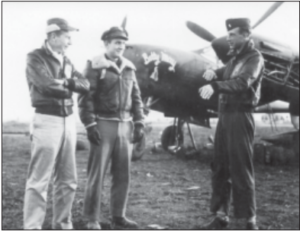
As published in the book P-38 Lightning Aces of the 82nd Fighter Group, Don (left) talking to fellow pilots Bob Kinnie and Paul Jorgenson. This photo was taken January 14, 1944, when Stoutenborough had just recorded his second aerial victory.
Did those moments make Stoutenborough contemplate the possibility that there might be a mission from which he would not return? He insists the thrill of flying that particular fighter outweighed the dangerous nature of his missions.
“I was having so much fun. It’s not hubris,” he clarifies. “It’s just the fact that I always wanted to fly. The P-38 was a magnificent plane to fly.”
A second aerial victory, this time knocking out an FW-190, would come on January 14, 1944, when escorting B-24s to Yugoslavia. But perhaps the closest call Stoutenborough survived had nothing to do with enemy forces. After completing his first tour and marrying his sweetheart, Phyllis, upon his return to the states, Stoutenborough returned to the 82nd Fighter Group, now operating out of Vincenzo Airfield near Foggia. On the first day of February, 1945, he was leading the group toward its rendezvous with American bombers, when his right engine went out.
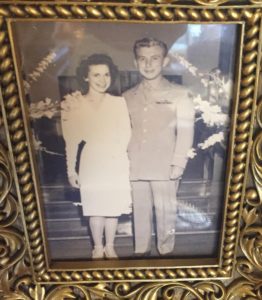
Don married Phyllis between his two tours of duty in WWII. They enjoyed 57 years of marriage before her passing.
The P-38s were already over enemy territory, but he knew he had to turn back toward Foggia, while the rest of the group continued on the mission. Already rattled by the loss of an engine on his usually dependable Lightning, Stoutenborough was shocked when the other engine started “coughing.” As he started to consider inverting the plane to bail out, he guessed that he had crossed back into territory controlled by the Allies. Any chance of jumping out of the plane disintegrated when the left engine, too, stopped working altogether.
“That engine went out on me, and it sunk like a rock,” you’ll hear him explain. “I’m coming down in a hurry and I don’t have time to go jump out.”
With little time to react, and battling flames that would leave him badly burned, he brought the Lightning in for a crash landing in a grove of olive trees right next to a hospital. He climbed out of the cockpit, and started to run away when the plane exploded. Quickly greeted by an ambulance, he estimates he reached the aforementioned hospital within 90 seconds. The 22-year-old suffered 1st, 2nd, and 3rd degree burns to his face, and spent the next two months in the hospital before returning to his unit. Listen to Hometown Heroes for Don’s unique and endearing story of the letter he sent home to Phyllis during this period.
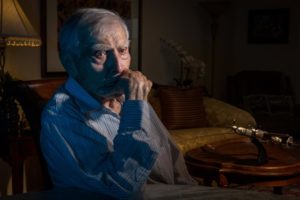
The contrast captured here by Zach Coco of Pictures for Heroes parallels the spectrum of Don Stoutenborough’s P-38 memories: some dark and heavy, others light-hearted and even thrilling.
A lifelong performer who had dreams of becoming an actor, and would later teach drama at the University of California in Riverside, Stoutenborough readily admits that some elements of his World War II story would be laughed off by screenwriters as too hard to believe. Among those is the most memorable flight he made after recovering from his burns, answering the call in early May, 1945 for a “courier with a toothbrush.” Listen to the interview for Don’s vivid description of his carrying 40 lbs. of mystery cargo around Paris, and the run-in he had with an irate general when he made it to London a day later than expected. It turns out he had been ferrying film capturing the final surrender of German forces in Italy, and the angst over the timing of the delivery related to its intended recipient: President Harry Truman.
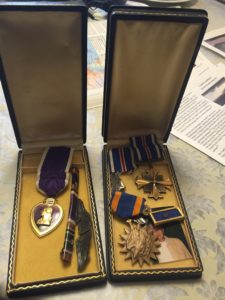
Don’s decorations include the Distinguished Flying Cross, the Purple Heart, and the Air Medal with 15 oak leaf clusters.
You’ll notice that Stoutenborough downplays his Distinguished Flying Cross, as well as his Purple Heart, suggesting he may not really be deserving of those decorations. A similar sentiment emerges when he is asked about his two confirmed aerial victories.
“I don’t want the credit for shooting a guy down,” you’ll hear the 95-year-old say. “If I really did it, I hope he hit the sack. I didn’t like killing anybody.”
His years in the Army Air Corps, as well as his post-war service in the Air National Guard, which allowed him to fly P-51 Mustangs, left Don with plenty of satisfaction. When asked what he is most proud of, you’ll hear the nonagenarian deliver a quick and authoritative response. “That I did what I did,” he says. “And my wife was with me.” Phyllis and Don raised three sons, and enjoyed 57 years of marriage before her passing. He now gets to keep her memory alive for five grandchildren and two great-grandchildren. They never would have been born if he didn’t survive those 76 missions in P-38s, and we wouldn’t have heard his story on the radio without Edwards Lifesciences.
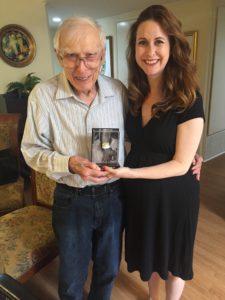
Don with Heather Bukant of Edwards Lifesciences, manufacturer of the transcatheter aortic heart valve replacement that changed his life.
The heart-focused medical device company has made it a point to honor the World War II veterans among the people who have benefited from the company’s heart valve replacements. It was through those efforts that Edwards’ Heather Bukant got to know Don, and she subsequently suggested that he be featured on Hometown Heroes. We wouldn’t have known about his unique story otherwise, and we can also say that Don might not have been able to share his story without the renewed energy and vigor his transcatheter aortic heart valve replacement has helped produce. Accustomed to walking at least two miles every day, especially during his years as a volunteer docent at Palm Springs Air Museum, he had seen his stamina decline severely. The valve replacement operation has made a significant difference. “I can go a mile and a half,” he says of his daily walks now. “But I couldn’t have done it if they hadn’t given me that.” It’s as if the P-38 pilot lost one of his engines, but found a way to get the prop turning again, a parallel you’ll hear him accept toward the conclusion of this episode. One theme that’s impossible to miss, from the start of this conversation to the finish, is the depth of his affinity and appreciation for that “magnificent” aircraft he first witnessed as a prototype before the war, and the one he still gazes at longingly, in model form, at his southern California home. Just in case you missed it along the way, Don has four more words for you, to clearly articulate his feelings for the P-38 Lightning:
“I love that plane.”
Watch the short video below for an extra taste of Don Stoutenborough’s P-38 passion, and click the Edwards Lifesciences logo to learn more about transcatheter heart valves like the one Don received.
—Paul Loeffler




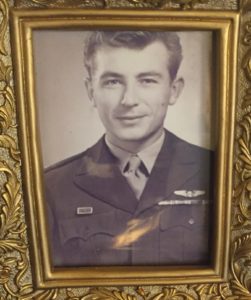
Unbelievable how sharp he is and how clearly he recalls the late 30’s and 40’s, I don’t know how they can remember such detail, I’m amazed show after show.
Just followed the Facebook link and listened to the podcast for the first time since I missed it Saturday, what a great way to listen! I can pause as I get in and out of the work truck and not miss a thing.